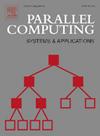Using Java to create and analyze models of parallel computing systems
IF 2.1
4区 计算机科学
Q2 COMPUTER SCIENCE, THEORY & METHODS
引用次数: 0
Abstract
The purpose of the study is to develop optimal solutions for models of parallel computing systems using the Java language. During the study, programs were written for the examined models of parallel computing systems. The result of the parallel sorting code is the output of a sorted array of random numbers. When processing data in parallel, the time spent on processing and the first elements of the list of squared numbers are displayed. When processing requests asynchronously, processing completion messages are displayed for each task with a slight delay. The main results include the development of optimization methods for algorithms and processes, such as the division of tasks into subtasks, the use of non-blocking algorithms, effective memory management, and load balancing, as well as the construction of diagrams and comparison of these methods by characteristics, including descriptions, implementation examples, and advantages. In addition, various specialized libraries were analyzed to improve the performance and scalability of the models. The results of the work performed showed a substantial improvement in response time, bandwidth, and resource efficiency in parallel computing systems. Scalability and load analysis assessments were conducted, demonstrating how the system responds to an increase in data volume or the number of threads. Profiling tools were used to analyze performance in detail and identify bottlenecks in models, which improved the architecture and implementation of parallel computing systems. The obtained results emphasize the importance of choosing the right methods and tools for optimizing parallel computing systems, which can substantially improve their performance and efficiency.
使用Java创建和分析并行计算系统的模型
本研究的目的是开发使用Java语言的并行计算系统模型的最佳解决方案。在研究过程中,为所研究的并行计算系统模型编写了程序。并行排序代码的结果是经过排序的随机数数组的输出。当并行处理数据时,将显示用于处理的时间和平方数列表的第一个元素。当异步处理请求时,将为每个任务显示处理完成消息,并有轻微延迟。主要结果包括算法和过程的优化方法的发展,例如任务划分为子任务,非阻塞算法的使用,有效的内存管理和负载平衡,以及图表的构建和这些方法的特征的比较,包括描述,实现示例和优势。此外,还分析了各种专用库,以提高模型的性能和可扩展性。所执行的工作结果表明,并行计算系统在响应时间、带宽和资源效率方面有了实质性的改进。进行了可伸缩性和负载分析评估,演示了系统如何响应数据量或线程数量的增加。利用分析工具详细分析性能并识别模型中的瓶颈,从而改进了并行计算系统的体系结构和实现。所得结果强调了选择正确的方法和工具来优化并行计算系统的重要性,这可以大大提高并行计算系统的性能和效率。
本文章由计算机程序翻译,如有差异,请以英文原文为准。
求助全文
约1分钟内获得全文
求助全文
来源期刊

Parallel Computing
工程技术-计算机:理论方法
CiteScore
3.50
自引率
7.10%
发文量
49
审稿时长
4.5 months
期刊介绍:
Parallel Computing is an international journal presenting the practical use of parallel computer systems, including high performance architecture, system software, programming systems and tools, and applications. Within this context the journal covers all aspects of high-end parallel computing from single homogeneous or heterogenous computing nodes to large-scale multi-node systems.
Parallel Computing features original research work and review articles as well as novel or illustrative accounts of application experience with (and techniques for) the use of parallel computers. We also welcome studies reproducing prior publications that either confirm or disprove prior published results.
Particular technical areas of interest include, but are not limited to:
-System software for parallel computer systems including programming languages (new languages as well as compilation techniques), operating systems (including middleware), and resource management (scheduling and load-balancing).
-Enabling software including debuggers, performance tools, and system and numeric libraries.
-General hardware (architecture) concepts, new technologies enabling the realization of such new concepts, and details of commercially available systems
-Software engineering and productivity as it relates to parallel computing
-Applications (including scientific computing, deep learning, machine learning) or tool case studies demonstrating novel ways to achieve parallelism
-Performance measurement results on state-of-the-art systems
-Approaches to effectively utilize large-scale parallel computing including new algorithms or algorithm analysis with demonstrated relevance to real applications using existing or next generation parallel computer architectures.
-Parallel I/O systems both hardware and software
-Networking technology for support of high-speed computing demonstrating the impact of high-speed computation on parallel applications
 求助内容:
求助内容: 应助结果提醒方式:
应助结果提醒方式:


